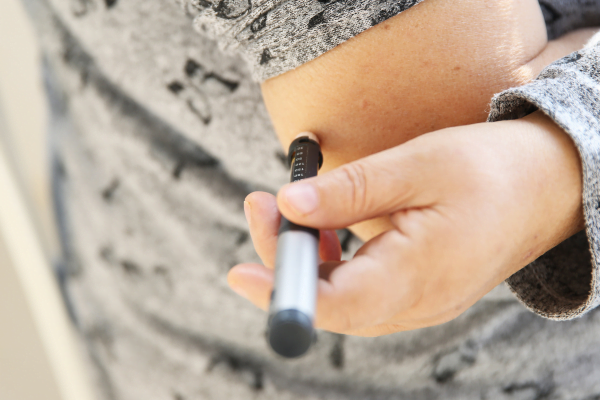Adlyxin (Lixisenatide) is a medication that lowers blood sugar levels in adults with type 2 diabetes mellitus. It helps the body produce more insulin, reduce the amount of glucose produced by the liver, and slow down the rate of food digestion.
Adlyxin cannot treat type 1 diabetes or diabetic ketoacidosis, a life-threatening condition that can occur in individuals with uncontrolled diabetes. Doctors usually prescribe this drug as part of a comprehensive diabetes management plan that includes diet, exercise, and other medications.
This article will summarize Adlyxin, its uses, dosage, and common side effects. It is crucial to seek the advice of a healthcare professional before starting Adlyxin or any other medication to manage diabetes.
Uses and Mechanism of Action
Adlyxin (Lixisenatide) is a medication designed to assist in regulating blood sugar levels in adults with type 2 diabetes. It achieves this by mimicking the effects of natural GLP-1 hormones, which play a crucial role in blood sugar regulation.
By stimulating the GLP-1 receptors in the pancreas, Adlyxin induces several beneficial actions:
Increased Insulin Production: Adlyxin prompts the pancreas to produce more insulin in response to high blood sugar levels, aiding in the reduction of blood sugar levels after meals.
Reduced Glucagon Release: This medication suppresses the secretion of glucagon, a hormone that can cause blood sugar levels to rise. By limiting glucagon release, Adlyxin further contributes to the control of blood sugar.
Slowed Gastric Emptying: Adlyxin slows down the rate at which the stomach empties its contents, leading to a more controlled and gradual entry of glucose into the bloodstream following a meal.
FDA Approval and Efficiency
Adlyxin (Lixisenatide) Approval Based on Extensive Research from GetGoal Clinical Program
The FDA approved Adlyxin based on extensive research from the GetGoal clinical program, which included 13 clinical trials involving over 5,000 individuals with type II diabetes worldwide. The primary goal of these studies was to reduce HbA1c levels, which is a measure of long-term blood sugar control.
The GetGoal initiative confirmed the effectiveness and safety of a daily 20 µg dose of lixisenatide for diverse groups of type 2 diabetes patients. It included individuals who were not using other antidiabetic medications, those who hadn’t responded well to oral agents, and those using it in combination with basal insulin therapy.
The results of these trials consistently showed significant reductions in HbA1c levels, typically ranging from 0.7% to 1.0%. Compared directly to exenatide at 10 μg twice daily, lixisenatide at 20 μg once daily proved equally effective in reducing HbA1c levels. Moreover, compared to exenatide, it had the benefit of causing fewer symptomatic hypoglycemia events and better gastrointestinal tolerance.
In addition, three randomized trials showed that adding lixisenatide to basal insulin treatment significantly improved glycemic control compared to a placebo. Patients experienced an improvement in post-meal glucose levels and tolerated the treatment well.
Overall, Adlyxin’s FDA approval relied on substantial clinical evidence from the GetGoal program, which demonstrated its effectiveness and safety in many individuals with type 2 diabetes, including those who did not respond to other treatments. It solidifies its status as a valuable tool for managing blood sugar levels in individuals with type 2 diabetes.
Dosage for Adlyxin
Please follow your doctor’s prescription for your dosage. The instructions given below are general guidelines and may/may not be applicable to you.
To administer Adlyxin, follow these guidelines for proper dosage and administration:
Dosage Regimen:
We should administer Adlyxin as a subcutaneous injection once a day. Experts recommend injecting it within one hour before the first meal of the day, typically breakfast.
Initial Dose:
For most patients, the starting dose of Adlyxin is 10 micrograms (mcg) once daily. Beginning with this lower dose is essential in order to assess your body’s response to the medication.
Titration:
After at least 14 days at the initial dose, the dosage of Adlyxin can be increased to 20 mcg once daily. This titration process ensures that you tolerate the medication well and that it effectively controls your blood sugar levels.
Individualization:
The final dose of Adlyxin may vary from person to person. Your healthcare provider will determine the appropriate dosage for you based on your specific needs and response to the medication.
Administration:
Adlyxin is a subcutaneous injection that you inject just below the skin. The recommended injection sites include the thigh, abdomen, or upper arm. It is important to rotate injection sites to minimize the risk of complications.
Side Effects Adlyxin
As with any medication, Adlyxin (Lixisenatide) may have side effects. Common side effects include:
- Nausea
- Vomiting
- Diarrhea
- Headache
- Dizziness
- Abdominal Pain
These adverse reactions are usually mild and improve over time. However, if you experience severe side effects, it is crucial to consult your healthcare provider.
Precautions and Warnings
Before starting Adlyxin (Lixisenatide) therapy for managing type 2 diabetes mellitus, it’s essential to consider the following precautions and warnings:
Adlyxin may cause hypoglycemia?
Adlyxin may cause low blood sugar (hypoglycemia), mainly when used in combination with other antidiabetic medications. It is crucial to be aware of the symptoms of hypoglycemia, such as shakiness, sweating, and rapid heartbeat, and seek immediate medical attention if it occurs.
Pancreatitis pain:
Some users of GLP-1 receptor agonists, including Adlyxin, have reported pancreatitis. Please inform your healthcare provider if you experience persistent severe abdominal pain or have a history of pancreatitis.
Possibilities of thyroid tumors:
Animal studies have indicated a possible increased risk of thyroid C-cell tumors with Adlyxin use. While the extent of this risk in humans is uncertain, it is essential to discuss any family history of thyroid cancer or other thyroid-related problems with your healthcare provider.
Adlyxin’s safety in pregnancy and lactation is uncertain:
The safety of Adlyxin during pregnancy and breastfeeding is not well-established. If you are pregnant, planning to become pregnant, or breastfeeding, consult your healthcare provider for guidance.
Adlyxin (Lixisenatide) is a valuable medication for managing type 2 diabetes mellitus. However, it is essential to use it under the direction of a healthcare professional and be aware of any potential precautions and warnings associated with its use. Remember to always consult your healthcare provider for personalized advice and treatment options for diabetes management.
Doctor’s Recommendation
Many patients starting lixisenatide may experience gastrointestinal side effects like nausea and vomiting, often due to delayed stomach emptying. While these symptoms can be tough at first, many patients get used to them over time. Headaches and dizziness are also possible. In studies, some patients stopped treatment because of these effects. To help manage these side effects, it’s recommended to start with smaller amounts of food and eat slowly.



